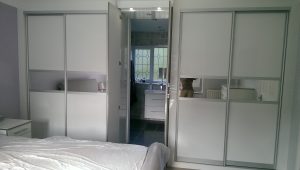7 Common Mistakes to Avoid When Installing Sliding Wardrobes
Sliding wardrobes are a game-changer when it comes to saving space and adding style to your home. But let’s be honest – installing them isn’t always as simple as it looks. One wrong move, and you could end up with doors that won’t close, uneven tracks, or a storage disaster.
The good news? You can avoid these headaches by steering clear of the most common installation mistakes. Let’s dive into the seven biggest errors people make – and how you can get it right the first time.

1. Inaccurate Measurements
Getting your measurements wrong is like building a house on shaky ground – it just won’t work. Even a small miscalculation can leave you with doors that don’t slide properly or gaps that ruin the sleek look.
Real-Life Example:
Sarah, a first-time DIYer, was excited about her new sliding wardrobe. She measured her space once (big mistake!) and ordered the wardrobe. When it arrived, she realized the doors were too wide, making installation impossible. She had to reorder custom doors, doubling her budget.
How to Avoid It:
- Measure at least twice – height, width, and depth.
- Account for skirting boards and uneven flooring.
- Follow the manufacturer’s size recommendations carefully.
2. Ignoring Wall and Floor Leveling
Sliding wardrobes need a stable foundation. If your floor or walls aren’t level, your doors may slide unevenly, scrape, or even get stuck.
Real-Life Example:
Mike installed his wardrobe on a slightly sloped floor, thinking it wouldn’t be an issue. A few weeks later, the doors started shifting off track, making them hard to close properly. A quick floor adjustment could have saved him the hassle.
How to Avoid It:
- Use a spirit level to check if your floor and walls are even.
- Fix any uneven areas before starting installation.
- If your floor is slightly uneven, use adjustable wardrobe feet.
3. Poor Interior Layout Planning
Your wardrobe may look good on the outside, but if the inside isn’t designed to suit your needs, it won’t be practical. Too many shelves, not enough hanging space, or awkward compartment sizes can turn it into a frustrating mess.
Real-Life Example:
Emma installed a sliding wardrobe without planning her storage needs. She ended up with too many small shelves and nowhere to hang her long dresses. She had to remove and redo the interior, costing extra time and money.
How to Avoid It:
- Plan your storage needs first – do you need more shelves, drawers, or hanging space?
- Consider adjustable shelving to allow for flexibility.
Consult with a Blenheim professional for guidance.
4. Misaligned Sliding Mechanisms
Sliding doors rely on perfectly installed tracks and rollers. If they’re off by even a few millimeters, you’ll deal with sticking, scraping, or jamming doors.
Real-Life Example:
Jake installed his wardrobe but didn’t align the tracks properly. At first, the doors slid fine, but over time, they started coming off the track. He had to take the whole thing apart and realign everything from scratch.
How to Avoid It:
- Follow the manufacturer’s installation guide carefully.
- Ensure tracks are level and secure.
- Test the doors before fully tightening the screws.
5. Using the Wrong Tools
DIY wardrobe installation is tempting, but using the wrong tools can lead to damaged panels, loose screws, and a frustrating experience.
Real-Life Example:
Liam used a regular screwdriver instead of a power drill to secure the tracks. The screws didn’t go in deep enough, and within days, the wardrobe started wobbling. He had to redo everything with the right tools.
How to Avoid It:
- Use the recommended tools (e.g., power drill, level, measuring tape).
- Avoid makeshift solutions – improvising can lead to damage.
- If unsure, consult a professional.
6. Overloading Shelves and Rails
Sliding wardrobes are sturdy, but they have limits. Overloading them can lead to sagging shelves, broken rails, and unnecessary repairs.
Real-Life Example:
Jessica crammed her wardrobe with heavy coats and storage boxes. Within a month, the hanging rod snapped, and her wardrobe interior had to be reinforced.
How to Avoid It:
- Check the manufacturer’s weight recommendations.
- Distribute weight evenly across shelves and rods.
- Avoid overloading one section – balance is key.
7. Skipping the Final Adjustments
Many people assume that once the wardrobe is assembled, the job is done. But skipping final adjustments can result in doors that don’t align properly or gaps that ruin the seamless look.
Real-Life Example:
Tom installed his wardrobe but didn’t fine-tune the door alignment. The small gap didn’t seem like a big deal—until dust and moisture started getting inside. He had to go back and readjust everything after a few months.
How to Avoid It:
- Check door alignment one last time before finishing up.
- Adjust screws and tracks if needed.
- Open and close the doors several times to ensure smooth operation.
Conclusion
Installing sliding wardrobes the right way can save you a lot of frustration. Taking the time to measure correctly, level the floor, plan the interior, and align tracks properly will ensure your wardrobe functions flawlessly for years. Whether you’re a DIY enthusiast or considering professional installation, avoiding these mistakes will make all the difference.
FAQs
- Why are accurate measurements important for sliding wardrobes?
Taking precise measurements ensures your wardrobe fits perfectly and functions correctly, preventing costly adjustments later. - How can I make sure my wardrobe doors slide smoothly?
Ensure your floor and walls are level, install tracks carefully, and test the doors before finalizing the installation. - What tools do I need for installation?
A power drill, level, measuring tape, screwdriver, and recommended fasteners are essential for a secure setup. - How do I avoid overloading my wardrobe?
Follow weight limits specified by the manufacturer and distribute weight evenly. - Can a professional installation save me time?
Absolutely! Hiring professionals ensures a perfect fit, proper alignment, and long-lasting durability.





